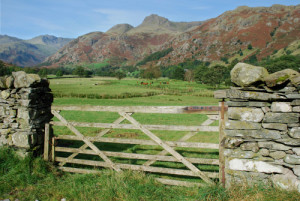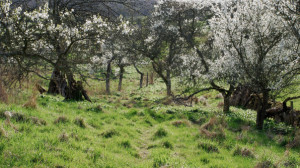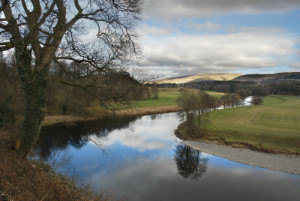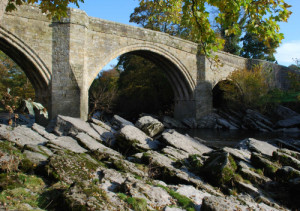Anyone who appreciates beautiful things will always have a special regard for Westmorland, that lovely land of towering mountains, heather-clad moors and exquisite towns and villages. The county possesses something unique, an indigenous culture unlike any other. Indeed, to the connoisseur Westmorland is a cornucopia of delights which, taken together, capture the very special spirit of the place. What then are the ‘must see’ sights of Westmorland, the things that contain the county’s essence? Here we present some of the indispensable highlights, the things to see for a taste of Westmorland. The list is, of course, far from exhaustive; indeed, the glories of Westmorland are inexhaustible.
The Langdale Pikes are the most famous mountains in Westmorland and present a spectacular sight to the tourists in Great Langdale as vast rockfaces soar precipitously to the twin peaks of Harrison Stickle and Pike o’Stickle. The only way to savour their essence, however, is to climb them! The path from the Dungeon Ghyll Hotel is well worn by generations of fellwalkers who couldn’t resist the allure of these Lakeland behemoths. It’s a steep ascent for the unfit or ill-shod, but those who make the effort are given a fantastic treat halfway up: suddenly before them the ground levels out and a wonderful mountain lake, Stickle Tarn, lies before them with mighty cliffs rearing up behind it. The dark waters of the tarn tempt the weary walkers to linger awhile and watch the rock climbers on the great rock buttress of Pavey Ark, some of them inching along Jack’s Rake, a route that seems to go straight across the bare cliff-face – surely Westmorland’s most hair-raising path. Saner souls venture on, along safer paths, to the very tops of the Pikes and stunning views of the surrounding hills and the secret valley of Mickleden seemingly miles below. Here in the hills, amid the cries of curlews and the bleats of Herdwick sheep, you can savour the authentic taste of Westmorland.
Lyth Valley Damsons offer us another Westmorland flavour to savour. In the south of the county, away from the mighty peaks of Langdale, the farms of the Lyth valley have long been noted for their damson orchards. These find their way into a bewildering array of local products: damson gin, damson wines, damson jelly, damson cheese, damson beer. In the past damsons from the Lyth valley were sent to Manchester cotton mills for use as dyes, while workers from the Lancashire cotton industry would organise outings every April to see one of the great sights of Westmorland: the spectacular damson blossom adorning the orchards and field boundaries of the Lyth farmsteads. Westmorland produces England’s finest damsons, local conditions favouring their production and propagation, and today no exploration of Westmorland would be complete without sampling the local damsons, the tiny fruit that made the Lyth valley famous.
Appleby Horse Fair is unique, a remarkable survival from a time in which horses dominated the world of agriculture and gypsies specialised in their buying and selling. The horse has been replaced by machinery of course, but gypsies still trade horses as enthusiastically as ever, and Westmorland’s county town is the place which famously gives itself over to its Romany Horse Fair in early June each year. In the run-up to that date the lanes and by-ways of northern England are often adorned by brightly painted Romany wagons or vardoes, all heading at their sedate, horse-drawn pace to the most famous fair of them all. Appleby Fair dates from 1685, the reign of James II, and has been held annually ever since. Originally, all types of livestock were traded; now it is just horses. The pretty town on the banks of the Eden welcomes huge numbers of horses during fair week, and they can be seen being washed by young traveller lads in the river and showing their paces in informal races along Flashing Lane. Interesting characters abound at Appleby Fair, and visitors can learn of the fascinating culture of the gypsies – their language, their customs – things seemingly from another age. Appleby Horse Fair is the authentic Westmorland experience par excellence.
Arnside Bore Tide is heralded by a warning siren which should remind all sane folk to vacate the sands and watch from a safe distance one of nature’s more intriguing spectacles. At Westmorland’s tiny coastline, the small resort of Arnside witnesses periodic bore tides as great quantities of water flowing into Morecambe Bay are bottle-necked into the estuary of the river Kent. Obviously, the bore tide varies greatly in its magnitude: all sorts of factors, such as the amount of water flowing down the Kent towards the sea or the direction of the prevailing wind, have an impact upon it. Nonetheless, the tide is a remarkable thing – although one or two brave or foolhardy souls view it as a perfect opportunity for some surfing practice! Arnside itself is a fascinating place and Arnside Knott, the little hill behind the town, is a wonderful spot to view the plants and creatures which live on limestone. Here ancient yew trees cling to the bare limestone outcrops and rare fritillery butterflies flit through woodland glades. The coastal path around Far Arnside provides a haven of rare beauty, as the woods and little cliffs tumble down to the glinting sheets of water on Morecambe Bay. All is peace and tranquility at Westmorland’s south-western tip – when the bore tide isn’t surging past, of course!
Ruskin’s View, just outside the pretty Westmorland market town of Kirkby Lonsdale, is rightly revered as a place of truly outstanding beauty. John Ruskin himself lived at Brantwood in Lancashire, and he travelled all over Europe, but it was in Westmorland that he discovered a view he considered sublime above all others. At the spot where the path from Kirkby Lonsdale churchyard commands a mighty vista of the river Lune meandering across lovely pastures with the fells behind, Ruskin decided he had found paradise. Who are we to argue?
Ruskin was in his day widely acknowledged as a pre-eminent judge of all things aesthetic – he wrote famous books on the architecture of Venice and on England’s greatest artists. Indeed, it was a painting by Turner, made on one of his northern tours, which alerted Ruskin to the fine view at Kirkby Lonsdale. Nowadays the vista is still lovely; indeed, the whole locale is replete with remarkable things, from Kirkby Lonsdale’s ornate market cross to the austere beauty of Devil’s Bridge as it strides across the Lune. Ruskin, that man of taste and discernment, wandered the world but found the loveliest view of all right here in Westmorland.
Rushbearing has gone on for generations in the Lakeland townships of Ambleside and Grasmere. Indeed, it has become an authentic Westmorland tradition, an annual event which binds communities and provides order and continuity in an ever-changing world. The origins of rush-bearing are not known precisely; suffice to say that the earth floors of churches in centuries past benefited from the strewing of sweet smelling rushes which absorbed dirt and created a fragrant atmosphere. Even today the summery aroma of the rush-strewn church of St Oswald in Grasmere is something special. Processions of children carry the rushes which are woven into ornate crosses and brought ceremonially to the church door accompanied a band and a great concourse of villagers and visitors. Curious customs such as these retain the authentic flavour of bygone days. Rush-bearing resonates with the true spirit of Westmorland and, like the sight of fell runners pounding the mountainside or the sound of hill shepherds chatting in the distinctive dialect of Westmorland, it brings England’s loveliest county instantly to mind.
Our list of Westmorland’s wonders, the sights and sounds that contain the county’s very essence, can never be complete. In a region such as this, with such a store of history, culture and natural beauty, every turn presents something new, some event or place which help define the ancient county which contains so much to interest and enchant.
(A version of this article has appeared in Lancashire Life magazine.)




